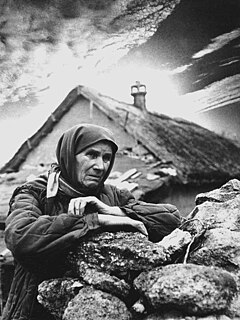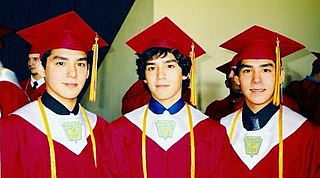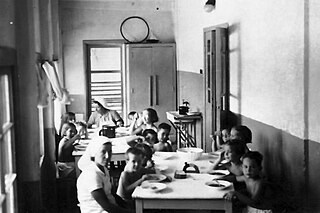 W
WThis article gives a list of individuals who have been romantically or maritally coupled with a sibling.
 W
WGrief is the response to loss, particularly to the loss of someone or some living thing that has died, to which a bond or affection was formed. Although conventionally focused on the emotional response to loss, grief also has physical, cognitive, behavioral, social, cultural, spiritual and philosophical dimensions. While the terms are often used interchangeably, bereavement refers to the state of loss, while grief is the reaction to that loss.
 W
WBirth order refers to the order a child is born in their family; first-born and second-born are examples. Birth order is often believed to have a profound and lasting effect on psychological development. This assertion has been repeatedly challenged. Recent research has consistently found that earlier born children score slightly higher on average on measures of intelligence, but has found zero, or almost zero, robust effect of birth order on personality. Nevertheless, the notion that birth-order significantly influences personality continues to have a strong presence in pop psychology and popular culture.
 W
WThe Birth Order Book: Why You Are the Way You Are is a 1982 non-fiction book by Christian psychologist Kevin Leman on birth order and its potential influence on personality and development. An updated and revised version of the book was published in 1998 through Baker Publishing Group. Leman first began studying birth orders while a student at the University of Arizona, after noticing that several elements of personality were associated with a person's birth order rank.
 W
WA brother is a man or boy who shares one or more parents with another, a sibling. The female counterpart is a sister. Although the term typically refers to a familial relationship, it is sometimes used endearingly to refer to non-familial relationships. A full brother is a first degree relative.
 W
WA bunk bed is a type of bed in which one bed frame is stacked on top of another, allowing two or more beds to occupy the floor space usually required by just one. They are commonly seen on ships, in the military, and in hostels, dormitories, summer camps, children’s bedrooms, prisons, and the like.
 W
WDNA profiling is the process of determining an individual's DNA characteristics. DNA analysis intended to identify a species, rather than an individual, is called DNA barcoding.
 W
WThe Donor Sibling Registry is a website and non-profit US organization serving donor offspring, sperm donors, egg donors and other donor conceived people. It was founded in September 2000 by a mother-and-son team, Wendy Kramer and Ryan Kramer of Nederland, Colorado.
 W
WCommonly, "cousin" refers to a "first cousin", a relative whose most recent common ancestor with the subject is a grandparent. More generally, in the lineal kinship system used in the English-speaking world, a cousin is a type of familial relationship in which two relatives are two or more familial generations away from their most recent common ancestor.
 W
WA generation is "all of the people born and living at about the same time, regarded collectively." It can also be described as, "the average period, generally considered to be about 20–30 years, during which children are born and grow up, become adults, and begin to have children." In kinship terminology, it is a structural term designating the parent-child relationship. It is known as biogenesis, reproduction, or procreation in the biological sciences.
 W
WFraternal birth order has been correlated with male sexual orientation, with a significant volume of research finding that the more older brothers a male has from the same mother, the greater the probability he will have a homosexual orientation. Ray Blanchard and Anthony Bogaert first identified the association in the 1990s and named it the fraternal birth order effect. Scientists have attributed the effect to a prenatal biological mechanism, since the association is only present in men with older biological brothers, and not present among men with older step-brothers and adoptive brothers. The mechanism is thought to be a maternal immune response to male fetuses, whereby antibodies neutralize male Y-proteins thought to play a role in sexual differentiation during development. This would leave some regions of the brain associated with sexual orientation in the 'female typical' arrangement – or attracted to men. Biochemical evidence for this hypothesis was identified in 2017, finding mothers with a gay son, particularly those with older brothers, had heightened levels of antibodies to the NLGN4Y Y-protein than mothers with heterosexual sons.
 W
WThis is a list of groups of siblings who achieved notability together, whether in music, arts or other spheres of life.
 W
WCommunal child rearing was the method of education that prevailed in the collective communities in Israel, until about the end of the 1980s.
 W
WA multiple birth is the culmination of one multiple pregnancy, wherein the mother gives birth to two or more babies. A term most applicable to vertebrate species, multiple births occur in most kinds of mammals, with varying frequencies. Such births are often named according to the number of offspring, as in twins and triplets. In non-humans, the whole group may also be referred to as a litter, and multiple births may be more common than single births. Multiple births in humans are the exception and can be exceptionally rare in the largest mammals.
 W
WSiblicide is the killing of an infant individual by its close relatives. It may occur directly between siblings or be mediated by the parents. The evolutionary drivers may be either indirect benefits for the genetic viability of a population or direct benefits for the perpetrators. Siblicide has mainly, but not only, been observed in birds.
 W
WTwins are two offspring produced by the same pregnancy. Twins can be either monozygotic ('identical'), meaning that they develop from one zygote, which splits and forms two embryos, or dizygotic, meaning that each twin develops from a separate egg and each egg is fertilized by its own sperm cell. In rare cases twins can have the same mother and different fathers.
 W
WThe Westermarck effect, also known as reverse sexual imprinting, is a psychological hypothesis that people tend not to be attracted to peers with whom they lived like siblings before age six. This hypothesis was first proposed by Finnish anthropologist Edvard Westermarck in his book The History of Human Marriage (1891) as one explanation for the incest taboo.